Latest Additions
  Class
144 'Pacer' Diesel Unit no. 144011 (24-02-20) : Paul Holroyd
https://kwvr.co.uk/class-144-pacer/ Class
144 'Pacer' Diesel Unit no. 144011 (24-02-20) : Paul Holroyd
https://kwvr.co.uk/class-144-pacer/
For a preserved railway, renowned for its collection of
steam locomotives of an age gone by, a Class 144 ‘Pacer’ may not seem an
obvious candidate for preservation. However as KWVR Chairman, Matt
Stroh, and Operating Company Director, Tim Moody, explain, these diesel
units deserve their place in preservation and the KWVR is an ideal
location for that to take place.
The Keighley & Worth Valley Railway is pleased to announce that
following 34 years of service on the local railway lines of West
Yorkshire, Class 144 ‘Pacer’ Diesel Unit number 144011 will be
transferred to us from Porterbrook Leasing Company, current owners of
the Class 144 units. The Class 144 ‘Pacer’ unit will move to our base in
Haworth following its retirement from operation on the national rail
network with Northern, currently expected to be in late May.
Matt Stroh, chairman of the Keighley & Worth Valley Railway Preservation
Society said, ‘Offering a Pacer a home on a West Yorkshire heritage
railway is very fitting, because these units have been the mainstay of
operation in the area for over three decades. We are very grateful to
Porterbrook Leasing for giving us this opportunity.’
Rupert Brennan Brown, Porterbrook’s Head of Communications and
Engagement, said: “We are delighted to be able to support the KWVR by
donating a Class 144 Pacer to their operational fleet. These trains were
in many ways the saviour of the social railway, so it is fitting that
one of these multiple units will continue to serve Keighley, as well as
communities along the Worth Valley and visitors to its world famous
railway.”
The Class 144 DMU was designed as a lowcost solution to the need to
replace some of the original first generation diesel multiple units,
dating from the 1950s.# It was designed and built by British Rail and
Walter Alexander in 1985 and introduced to passenger service in 1986.
The Class 144 was delivered new to Leeds Neville Hill depot, and soon
took over operations on the Airedale Line between Leeds/Bradford and
Skipton and was the mainstay of the local services through Keighley
until electrification in the late 1990s.
After electrification they continued to be regular visitors through
Keighley, mainly operating the Leeds – Skipton – Lancaster service,
something they could still be seen regularly operating until December
2019. Class 144 units have spent their entire working lives operating
local services throughout West Yorkshire and can often be cited for
re-invigorating declining local services and supporting the re-opening
of many local stations after they were introduced.
Tim Moody, from the KWVR, said “We believe that the Keighley & Worth
Valley Railway is an ideal home for a Class 144. We appreciate that our
wide variety of steam locomotives hauling period carriages will continue
to be the main attraction for many visitors, but we also recognise that
preservation and history does not standstill or stop at a set point in
time. What is considered modern and maybe unloved today is tomorrow’s
history and heritage.”
“With only 23 Class 144s ever being built, and having worked in West
Yorkshire their entire lives, they are an important part of the story of
rail travel in our local area and we believe that with suitable
interpretation it will become an interesting and valuable asset which
visitors, young and old can continue to ride on and experience, now and
in the future. The Class 144 will further the objectives of the Society
and I believe will attract new visitors in the future, especially
younger generations, which is vitally important for working museums such
as ours”.
# First generation diesel multiple units
First generation diesel multiple units are represented on the KWVR by
the current operational Class 101 and under restoration Class 108. As
their successors are now being withdrawn, it is appropriate that a
‘Pacer’ finds a new home, here on the KWVR. |
Maps
/005%20Ingrow_small.jpg) Ingrow
stations map (1890) : Malcolm Mallison Ingrow
stations map (1890) : Malcolm Mallison
6 inch maps from the 1890 survey. Both stations shown.
see also Queensbury Keighley section |
/007%20Oakworth_small.jpg) Oakworth
station map (1890) : Malcolm Mallison Oakworth
station map (1890) : Malcolm Mallison
6 inch maps from the 1890 survey. |
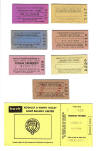 Keighley
& Worth Valley tickets Keighley
& Worth Valley tickets |
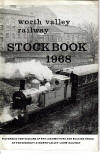  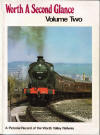 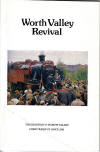 Keighley
& Worth Valley Stock Books Keighley
& Worth Valley Stock Books |
   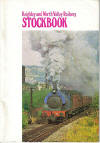
Keighley & Worth Valley Stock Books |
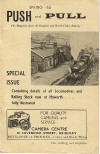 Push
and Pull magazine Push
and Pull magazine
The first edition of the Keighley & Worth Valley Railway's house
magazine,
Push and Pull, has been reprinted several times over the
years.
Here is the much rarer issue no. 2 |
 Push
and Pull magazine Push
and Pull magazine
The first issue of Push and Pull to be published after the re-opening of
the branch featured USA 0-6-0 tank no 30072 on the cover. This was one
of two locomotives which hauled the re-opening special train |
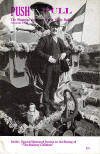 Push
and Pull magazine Push
and Pull magazine
The EMI version of The Railway Children, with Jenny Agutter and Bernard
Cribbins, really put the branch line on the map.
The Autumn 1970 edition
included a feature on the making of the film. |
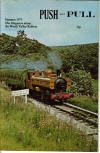 Push
and Pull magazine Push
and Pull magazine
Colour cover on the Summer 1973 edition of Push and Pull, with ex-Great
Western Railway pannier tank no. 5775 in its Railway Children livery. |
 Push
and Pull magazine Push
and Pull magazine
Colour covers became a permanent feature from the Spring 1981 issue of
Push and Pull. |
 Push and Pull magazine
Push and Pull magazine |
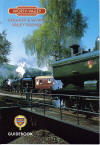 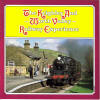   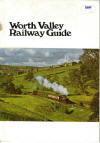 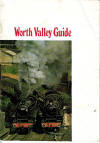 Worth
Valley Guides Worth
Valley Guides |
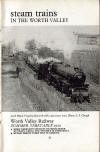 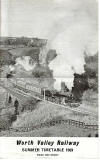 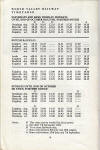 Worth
Valley timetables Worth
Valley timetables
1968 - 1970 |
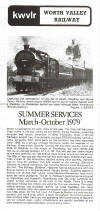 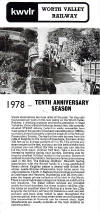 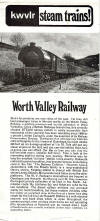  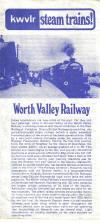 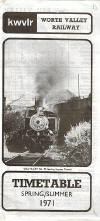 Worth
Valley timetables Worth
Valley timetables
1971 - 1979 |
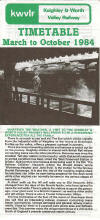 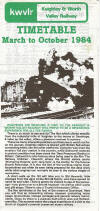 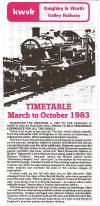 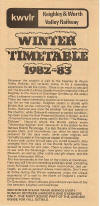 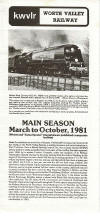 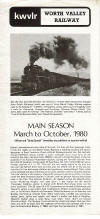 Worth
Valley timetables Worth
Valley timetables
1980 - 1984 |
 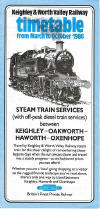 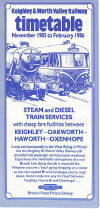 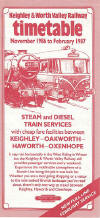 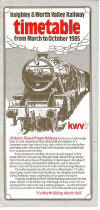 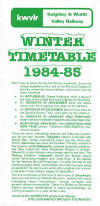 Worth
Valley timetables Worth
Valley timetables
1984 - 1987 |
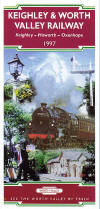 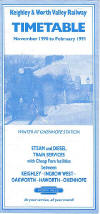 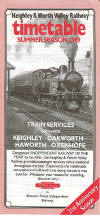 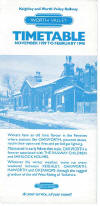 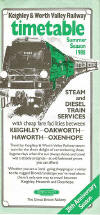 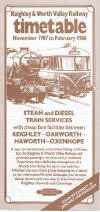 Worth
Valley timetables Worth
Valley timetables
1987 - 1997 |
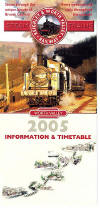  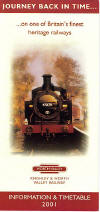 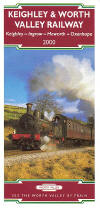 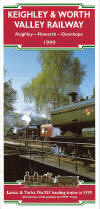  Worth
Valley timetables Worth
Valley timetables
1998 - 2005 |
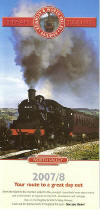   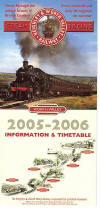 Worth
Valley timetables Worth
Valley timetables
2005 - 2008 |
 Worth
Valley Gradient profile Worth
Valley Gradient profile |
Vintage Locomotives & Carriages
 Two carriages from the Ingrow
Museum of Rail Travel form a special train at Platform 4, Keighley. Two carriages from the Ingrow
Museum of Rail Travel form a special train at Platform 4, Keighley.
The carriages are a Manchester, Sheffield & Lincolnshire Railway
tri-composite of 1876 vintage, and a Great Northern Railway Brake Composite
built in 1898.
The locomotive is no. 47279, built in 1924 at the Vulcan Foundry,
Newton-le-Willows for the London, Midland and Scottish Railway. |
 Vintage
Carriages Vintage
Carriages
Another view of the same special train. Note the signalbox from Shipley
Bingley Junction on Platform 3. |
 Black
5 (28-04-84) Black
5 (28-04-84)
Visiting "Black Five" loco no
5305, designed by Sir William A. Stanier, runs round its train at Keighley
28 April 1984. |
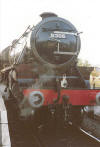 Black
5 (28-04-84) Black
5 (28-04-84)
Visiting "Black Five" loco no
5305, designed by Sir William A. Stanier, backs onto its train at Keighley,
28 April 1984. |
 Headboard (28-04-84) Headboard (28-04-84)
Affixing the Northolt Model
Railway Club's headboard to LMS design 8F no 8431 designed by Sir William A.
Stanier, at Keighley. Note the two sleeping cars awaiting disposal in the
turntable road.
28 April 1984. |
 Metropolitan
Railway Carriages (28-04-84) Metropolitan
Railway Carriages (28-04-84)
Metropolitan Railway Carriages 465
and 427, now on display at the Ingrow Museum of Rail Travel,
provide the
accommodation for the Northolt Model Railway Club. Keighley 28 April 1984. |
 Sleeping
cars Keighley (c1984) Sleeping
cars Keighley (c1984)
Old sleeping cars await disposal
at Keighley, 1984.
See
http://www.vintagecarriagestrust.org/se/CarriageInfo.asp?Ref=954
http://www.vintagecarriagestrust.org/se/CarriageInfo.asp?Ref=953 |
 Keighley 28 April 1984 Keighley 28 April 1984 |
 Brussels,
Keighley (23-09-83) Brussels,
Keighley (23-09-83)
Brussels, built in 1945 by Hudswell Clarke of Leeds for the Longmoor Military Railway in Hampshire,
takes water at Keighley 23 September 1983. |
 Brussels,
Keighley (25-09-83) Brussels,
Keighley (25-09-83)
Brussels, built in 1945 by HudswellClarke of Leeds for the Longmoor Military Railway in Hampshire
25 September 1983 Keighley.
|
 Brussels,
Keighley (31-03-84) Brussels,
Keighley (31-03-84)
Brussels at Keighley 31 March 1984. |
 Brussels,
Keighley (31-03-84) Brussels,
Keighley (31-03-84)
Brussels
31 March 1984 Keighley.
|
 Brussels,
Keighley (31-03-84) Brussels,
Keighley (31-03-84)
Brussels Keighley 31 March 1984. |
 Bulleid
and Brussels, Keighley (31-03-84) Bulleid
and Brussels, Keighley (31-03-84)
City of Wells, designed for the
Southern Railway by Oliver Vaughn Snell Bulleid, and Brussels
Keighley 31 March 1984. |
 Vulcan,
Keighley (1980s) Vulcan,
Keighley (1980s)
Vulcan, a 500 h.p. prototype
diesel locomotive built in 1956 by English Electric at Vulcan Foundry,.
Newton-le-Willows.
The locomotive has been based on the Keighley & Worth
Valley Railway since March 1966.
Photographed at Platform 4, Keighley in the 1980s. |
 Railbus,Keighley
(11-08-06) Railbus,Keighley
(11-08-06)
Railbus built in 1958 by Waggon
und Maschinenbau of Donauworth, West Germany. Keighley 11 August 2006. |
 Keghley
station (10-94) Keghley
station (10-94)
Platform 4 of Keghley station,
photographed in October 1994.
The transport relics shop at the end of
platform 4 relocated to Ingrow in June 2003 |
 Plaque,
Keighley station (07-08-06) Plaque,
Keighley station (07-08-06)
"1998 Independent Railway of the
Year" plaque, displayed on Platform 4 of Keighley station.
Photographed 7 August 2006. |
 Keighley
station (07-08-06) Keighley
station (07-08-06)
Next train departure indicator on
Platform 4 of Keighley station. Photographed 7 August 2006. |
 B.R
Standard Class 4MT (07-08-06) B.R
Standard Class 4MT (07-08-06)
British Railways Standard Class
4MT no. 80002, built at Derby in 1951 to the design of R.A. Riddles.
Keighley 7 August 2006 |
 Keighley
station Keighley
station
Platform 3 of Keighley station,
before the canopy was extended. |
 Keighley
station Keighley
station
Platform 3 at Keighley, after the Garsdale turntable had been installed,
but before the Shipley Bingley
Junction signalbox was moved to Keighley. |
 Keighley
station, turntable Keighley
station, turntable
Keighley turntable and picnic
area. |
 Keighley
station, turntable Keighley
station, turntable
Keighley turntable. |
 Keighley
station Keighley
station
The extended canopy on
platform 4 of Keighley station, above the Transport Relics Shop.
The transport relics shop at the end of platform 4 relocated to Ingrow in
June 2003 |
 Keighley
station Keighley
station
The newly extended
canopy on Platform 4 at Keighley, with the Class 108 DMU.
Note the overhead
live wires sign on the new canopy. |
Ingrow West (12-06-82)
 City of Wells enters the tunnel at Ingrow West, 12 June 1982. The original station buildings at Ingrow west
were badly vandalised. However, the station building from Foulridge was
dismantled and re-erected at Ingrow. City of Wells enters the tunnel at Ingrow West, 12 June 1982. The original station buildings at Ingrow west
were badly vandalised. However, the station building from Foulridge was
dismantled and re-erected at Ingrow.
On 22 July 1989 the re-located station building was formally opened.
Easter 1990 saw the opening of Vintage Carriages Trust's museum at Ingrow.
On 31 March 2002, Ingrow Loco Museum, owned by the Bahamas Locomotive
Society, opened for business. |
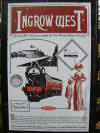 Poster Poster
Poster explaining how the station
building from Foulridge was rebuilt at Ingrow West. |
A series of photos
showing how Ingrow Railway Centre has developed over the years.
As well as being the location of two museums, Ingrow Railway Centre has been
used for a number of vintage vehicle displays,
often featuring vehicles from
the Keighley Bus Museum Collection.
|
 Ingrow
Railway Centre Ingrow
Railway Centre |
   Ingrow
Railway Centre Ingrow
Railway Centre
Ingrow is also where visiting locomotives are unloaded from road trailers. |
   Visiting Western Region "Warship" class D 832 Onslaught is unloaded at
Ingrow Railway Centre. Visiting Western Region "Warship" class D 832 Onslaught is unloaded at
Ingrow Railway Centre. |
  London
Transport buses London
Transport buses
Todmorden and London
Transport buses join forces with an LMS loco and a shire horse. |
 Signal
box Signal
box
Signal box about to
leave Ingrow Railway Centre. |
   Crank-ups Crank-ups
The Aire Valley
Vintage Machinery Club holds regular "crank-ups" of stationary engines at
Ingrow Railway Centre |
 Lost
Beers Of West Yorkshire Lost
Beers Of West Yorkshire
Do you remember Ramsden's Stone Trough Ales?
CWX 671, a Bristol of Keighley - West Yorkshire with lowbridge bodywork
(upstairs there are bench seats for 4 people and a sunken side gangway)
|
  Sir
Berkeley Sir
Berkeley
Sir Berkeley, built by
Manning wardle of Leeds, together with Lord Mayor, built by Hudswell Clarke
of Leeds and the North Eastern Railway inspection saloon which was featured
in the 1970 EMI film of The Railway Children. Note the wooden doors of the
museum building. |
  VCT
museum VCT
museum
Inside the VCT museum at Ingrow, before the purpose-built central
viewing platform was introduced |
 VCT
museum VCT
museum
Before the shop and
magazine room were added to the VCT museum. |
 Coal
Tank Coal
Tank
London & North Western
Railway "Coal Tank" no. 1054 on a Vintage Train at Ingrow West. |
 VCT
museum VCT
museum
A general view showing
both museums at Ingrow. |
 VCT
museum VCT
museum
Note the wooden doors
on the front of the museum. |
 VCT
museum VCT
museum
The VCT museum in
October 1994, before the sidways extension was built. |
 VCT
museum VCT
museum
Metropolitan Railway
no. 1 and Sir Berkeley. |
 VCT
museum VCT
museum
Building phase 2 of the VCT museum, August 1995. Note the Thornycroft lorry. |
_small.jpg) VCT
museum VCT
museum
After Phase 3 of the VCT museum had been built. |
 VCT
museum VCT
museum
Building Phase 2 of the VCT museum, August 1995. |
 VCT
museum VCT
museum
Ex Lancashire &
Yorkshire Railway 0-6-0, as BR bno. 52044 hauls vintage carriages out of the
Museum of Rail Travel at Ingrow West. |
 VCT
museum VCT
museum
Great Northern Railway 2856 at Ingrow before restoration.
See
http://www.vintagecarriagestrust.org/se/CarriageInfo.asp?Ref=863
|
 Halifax
buses Halifax
buses
Halifax buses, now preserved by the Kerighley Bus Museum. - www.kbmt.org.uk
The Halifax buses were previously at
Transperience Low Moor. |
 Hudswell
Clarke (04-06-07) Hudswell
Clarke (04-06-07)
Two very different locomotives built by Hudswell Clarke of Leeds: Lord
Mayor of 1893 and D 2511 of 1961
4 June 2007. |
 Railbus
(09-09-06) Railbus
(09-09-06)
Railbus leaves the
Ingrow Museum of Rail Travel, 9 September 2006. |
 Damems Damems
The tiny station at
Damems closed to passengers in 1949, so it never had totems in British
Railways days. |
 Damems
signalbox
(c1990) Damems
signalbox
(c1990)
The signalbox was
originally located at Earby Crossing on the Skipton - Colne line.
The station building in this 1990s photo was originally a checker's office
inside Keighley goods shed.
It has since been replaced by a replica of the original Damems building of
Midland Railway days. |
 Damems Damems
The platform at Damems
is only long enough to accommodate one carriage, and normally sees very few
passengers.
The structure at the end of the platform has been replaced by an attractive
curved-roofed lamp room. |
 Damems
(03-08-07) Damems
(03-08-07)
Damems station on 03
August 2007. |
 Damems
(04-02) Damems
(04-02)
The replica of the
Midland Railway building can be seen in this view, taken in April 2002
during filming of The Hound of the Baskervilles, with vintage Great Northern
and Metropolitan Railway carriages from the Ingrow Museum of Rail Travel,
together with the Lancashire & Yorkshire Railway 0-6-0. |
 Damems
(27-01-08) Damems
(27-01-08)
The replica Midland Railway station building at Damems 27 January
2008. |
 Damems
(27-01-08) Damems
(27-01-08)
The lamp hut at Damems station 27 January 2008. |
 Damems Damems
The level crossing
gates at Damems. Immediately beyond the crossing gates, on private land, is
a Great Northern Railway carriage body. |
 Damems Damems
One half of the Great Northern Railway carriage body, located on private
property near Damems station. Until 1996,
the carriage was located in
the Doncaster area, and sadly its occupier was murdered.
See
http://www.vintagecarriagestrust.org/se/CarriageInfo.asp?Ref=2516
|
Damems
Junction (01-02)
 Immediately after the
level crossing at Damems station, there is the passing ;loop at Damems
Junction. Immediately after the
level crossing at Damems station, there is the passing ;loop at Damems
Junction.
Here we see Taff Vale Railway no. 85 hauling carriages from the Midland,
Manchester Sheffield & Lincolnshire and Great Northern Railways, during the
filming of Turner - the Man Who Painted Britain in January 2002.
If you look out of the train window when you are at the passing loop,
you can see the trackbed of the Great Northern Railway Keighley –
Queensbury route disappearing into the stone portal of Lees Moor Tunnel.
See Queensbury to Keighley page |
 Oakworth
(c1980) Oakworth
(c1980)
In 1968 BBC TV filmed
The Railway Children at Oakworth station, which was renamed Meadow Vale for
the series.
For the 1970 EMI film Oakworth was allowed to retain its real
identity.
Oakworth has changed very little since this 1980s view. |
 Oakworth
(13-06-82) Oakworth
(13-06-82)
Oakworth 13 June 1982,
with period advertisements to the fore. |
 Oakworth
(13-06-82) Oakworth
(13-06-82)
Oakworth 13 June 1982. |
 Oakworth
(13-06-82) Oakworth
(13-06-82)
"West Country" pacific
City of Wells, designed by Oliver Vaughan Snell Bulleid, steams into
Oakworth 13 June 1982. |
 Oakworth
(13-06-82) Oakworth
(13-06-82)
City of Wells leaves Oakworth with a train for Damems, Ingrow West and Keighley, 13 June 1982. |
 Oakworth
(01-02) Oakworth
(01-02)
Oakworth continues to
be popular with film companies.
Taken during the making of Turner - the Man
Who Painted Britain, January 2002. |
 Ingrow
Museum of Rail Travel (04-06-07) Ingrow
Museum of Rail Travel (04-06-07)
Lancashire and
Yorkshire Railway no. 957, together with vintage carriages from the Ingrow
Museum of Rail Travel.
Taken during the filming of Brideshead Revisited on 4
June 2007.
Click here for further details about the filming -
http://www.vintagecarriagestrust.org/film07brideshead.htm |
 Ingrow
Museum of Rail Travel (04-06-07) Ingrow
Museum of Rail Travel (04-06-07)
Vintage carriages from
the Ingrow Museum of Rail Travel at Oakworth, 4 June 2007. |
 Film
crew, Mytholmes Film
crew, Mytholmes
The film crew alight
from the train at Mytholmes curve during the filming of Turner - the Man Who
Painted Britain. |
 Haworth
(c1990) Haworth
(c1990)
Haworth yard, possibly 1990s. |
 Haworth
(nd) Haworth
(nd)
Mark 1 BG in Haworth
yard. Undated. |
 Haworth
(nd) Haworth
(nd)
Class 08 diesel,
Brussels and D 5209 in Haworth yard. Undated. |
 Haworth
(nd) Haworth
(nd)
44767 in Haworth new
shed. Undated. |
 Haworth
(nd) Haworth
(nd)
48431 arrives at
Haworth station. Undated. |
 Haworth,
Gresley Haworth,
Gresley
Sir Nigel Gresley’s
corridor tender in seen in this view in Haworth yard. |
 Haworth,
Gresley Haworth,
Gresley
A4 pacific no. 4498,
named after its designer, Sir Nigel Gresley, is seen in Haworth yard. |
 Haworth,
Gresley Haworth,
Gresley
Cleaning out the
smokebox of A4 pacific no 4498, Sir Nigel Gresley, at Haworth. |
 Oxenhope
(20-06-81) Oxenhope
(20-06-81)
Oxenhope 20 June 1981
with ex Lancashire & Yorkshire Railway 0-6-0 no. 957 and ex Manchester Ship
Canal no. 67 nearest the camera. |
Oxenhope, U.S. Army (20-06-81)
 Ex
U.S. Army Transportation Corps S.160 class 2-6-0 no 5820 at Oxenhope 20
June 1981. Ex
U.S. Army Transportation Corps S.160 class 2-6-0 no 5820 at Oxenhope 20
June 1981.
The locomotive was built in 1945 by Lima of Ohio, U.S.A. The loco became
Polish Railways Tr203-474. In 1975 it received a new boiler from an Alco
locomotive of the same type, and the boiler still carries the original
maker’s plate on the smokebox. The locomotive arrived at Haworth in
November 1977, and the following year it was used for sequences in the
film “Yanks”. |
 Oxenhope
(20-06-81) Oxenhope
(20-06-81)
Carriages at Oxenhope 20 June 1981: ex London Midland & Scottish
Railway no. 12066 (built in 1938 at Wolverton); Metropolitan-Cammell
diesel multiple unit buffet trailer no. 59575 (built in 1960); a Mark 1
Tourist Second Open, and a Mark 1 Suburban Brake Second (built in 1955
at York) |
 Oxenhope
(13-06-81) Oxenhope
(13-06-81)
“West Country” pacific
no. 34092 City of Wells at Oxenhope 13 June 1982. |
 Oxenhope
(25-09-83) Oxenhope
(25-09-83)
Mark 1 Restaurant Miniature Buffet no. 1836 at
Oxenhope, 25 September 1983. The carriage was built at Wolverton in
1960.
Further details:
http://www.vintagecarriagestrust.org/se/CarriageInfo.asp?Ref=1144 |
 Oxenhope
(14-01-84) Oxenhope
(14-01-84)
Oxenhope carriage sidings on a wintry 14 January
1984, with ex-Metropolitan Railway no. 465 and Midland Railway no. 358
(built at Derby in 1886) exposed to the elements.
These carriages are usually on public display at the Ingrow Museum of
Rail Travel. |
 Oxenhope
(31-03-84) Oxenhope
(31-03-84)
British Railways railbus, built in 1958 by Waggon
und Maschinenbau of Donauworth, West Germany.
Photographed at Oxenhope 31 March 1984. |
 Oxenhope
(31-03-84) Oxenhope
(31-03-84)
The carriage sidings at Oxenhope on 31 March 1984,
with Metropolitan Railway Brake Third no. 427 on the right in front of
the carriage workshop. This carriage has been used in many filming
assignments, and is normally on public display at the Ingrow Museum of
Rail Travel. |
Oxenhope (28-04-84)
 Ex
– Metropolitan Railway First Class carriage no. 509 undergoing
restoration at Oxenhope on 28 April 1984. Nowadays, it is difficult to
imagine that parts of the London Undergound had First Class accommodation,
but First Class survived on the Underground until October 1941. The
Metropolitan Railway even had two Pullman cars, Mayflower and Galatea,
which were used until 1939. This particular carriage survived in
passenger service until September 1961. Nowadays the carriage is in
varnished teak livery and it is usually on public display at the Ingrow
Museum of Rail Travel. Ex
– Metropolitan Railway First Class carriage no. 509 undergoing
restoration at Oxenhope on 28 April 1984. Nowadays, it is difficult to
imagine that parts of the London Undergound had First Class accommodation,
but First Class survived on the Underground until October 1941. The
Metropolitan Railway even had two Pullman cars, Mayflower and Galatea,
which were used until 1939. This particular carriage survived in
passenger service until September 1961. Nowadays the carriage is in
varnished teak livery and it is usually on public display at the Ingrow
Museum of Rail Travel.
Further details
http://www.vintagecarriagestrust.org/se/CarriageInfo.asp?Ref=1083 |
 Oxenhope
(28-04-84) Oxenhope
(28-04-84)
LMS no. 8431 runs round at Oxenhope 28 April 1984. |
 Oxenhope
(28-04-84) Oxenhope
(28-04-84)
The Northolt Model Railway Club’s headboard on LMS
no. 8431 at Oxenhope, 28 April 1984. |
 Oxenhope
(28-04-84) Oxenhope
(28-04-84)
The carriage sidings at
Oxenhope 28 April 1984. A carriage shed now occupies the area on the right. |
 Oxenhope
(28-04-84) Oxenhope
(28-04-84)
English Electric diesel Vulcan shunts Restaurant
Miniature Buffet no. 1836 at Oxenhope Carriage Workshops, 28 April 1984. |
 Oxenhope
(29-12-85) Oxenhope
(29-12-85)
43924 at Oxenhope, Sunday 29 December 1985. Photo: Paul Holroyd
collection. |
 Oxenhope
(30-12-85) Oxenhope
(30-12-85)
Ex Haydock Foundry
0-6-0 well tank Bellerophon at Oxenhope Monday 30 December 1985. |
 Oxenhope
(nd) Oxenhope
(nd)
The KWVR’s dining train in Oxenhope carriage
sidings. Undated. |
 Oxenhope
(c1980) Oxenhope
(c1980)
Pullman Parlour Third Mary , built in 1930 at
Smethwick by the Birmingham Railway Carriage & Wagon Co. Ltd.
Photographed in the 1980s at Oxenhope carriage sidings. |
 Oxenhope
(c1980) Oxenhope
(c1980)
Oxenhope carriage platform in the 1980s, with
Metropolitan Railway Brake Third no. 427. |
 Oxenhope
(c1980) Oxenhope
(c1980)
The class 08 diesel at
Oxenhope carriage sidings. 1980s. |
